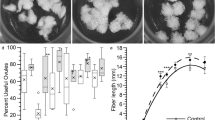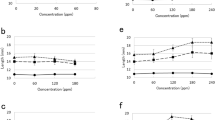Abstract
The effects of 5-bromo-2-deoxyuridine (BUdR, thymidine analogue), AMO-1618 (2-isopropyl-4-dimethylamino-5-methylphenyl-1-piperidine carboxylate methyl chloride), a growth retardant, and p-chlorophenoxyisobutyric acid (PCIB, an antiauxin) on growth (dry weight increase) and fiber development in unfertilized cotton (Gossypium hirsutum L.) ovules grown in vitro have been studied. BUdR (5 μM) causes about 70% inhibition of fiber production, with little effect on ovule growth, if applied during the first 6 d of culture in the presence of GA3 and IAA. AMO-1618, when used with GA3 alone, causes only a small reduction in both dry weight and fiber production, but when used with IAA alone reduces both fiber production and dry weight, the effect on the latter being predominant. In the presence of both IAA and GA3, AMO-1618 causes a small decrease in fiber production but a major decrease in dry weight. PCIB completely inhibits fiber growth but has little effect on dry weight, especially when GA3 is present. These results indicate that GA3 mainly promotes ovule growth while IAA is largerly responsible for fiber growth.
Similar content being viewed by others
Abbreviations
- AMO-1618:
-
2-isopropyl-4-dimethylamino-5-methylphenyl-1-piperidine carboxylate methyl chloride
- BUdR:
-
5-bromo-2-deoxyuridine
- GA3 :
-
gibberellic acid
- IAA:
-
indole-3-acetic acid
- PCIB:
-
p-chlorophenoxyisobutyric acid
- TFU:
-
total fiber units
References
Abbott, J., Holtzer, H.: The loss of phenotypic traits by differentiated cells. V. The effect of 5-bromodeoxyuridine on cloned chondrocytes. Proc. Nat. Acad. Sci. USA 59, 1144–1151 (1968)
Baldev, B., Lang, A., Agatep, A.D.: Gibberellin production in pea seeds developing in excised pods: effect of growth retardant AMO-1618. Science 147, 155–157 (1965)
Beasley, C.A.: Glasshouse production of cotton flowers, harvest procedures, methods of ovule transfer, and in vitro development of immature seed. Cotton Grow. Rev. 51, 293–301 (1974)
Beasley, C.A., Ting, I.P.: Phytohormone effects on in vitro cotton seed development. In: Plant Growth Substances. VIII Int. Conf. on Plant Growth Substances, pp. 907–914, Tokyo: Hirokawa 1973
Beasley, C.A., Ting, I.P.: Effects of plant growth substances on in vitro fiber development from unfertilized cotton ovules. Amer. J. Bot. 61, 188–194 (1974)
Beasley, C.A., Birnbaum, E.H., Dugger, W.M., Ting, I.P.: A quantitative procedure for estimation of growth of cotton fibers. Stain Technol. 40, 85–92 (1974a)
Beasley, C.A., Ting, I.P., Delmer, D.P., Linkins, A.E., Birnbaum, E.H.: Cotton ovule culture: A review of progress and a preview of potential In: Tissue culture and plant science, pp. 169–192, Street, H.E., ed. New York: Academic Press 1974(b)
Cleland, R.: Evidence on the site of action of growth retardants. Plant Cell Physiol. 6, 7–15 (1965)
Cleland, R.: Cell wall extension. Ann. Rev. Plant Physiol. 22, 197–222 (1971)
Cleland, R., McCombs, N.: Gibberellic acid: action in barley endosperm does not require endogenous auxin. Science 150, 497–498 (1965)
Coleman, A.W., Coleman, J.R., Kankel, D., Werner, I.: The reversible control of animal cell differentiation by the thymidine analog, 5-bromodeoxyuridine. Exp. Cell Res. 59, 319–328 (1970)
Daniel, J.C.: Changes in type of collagen synthesized by chick fibroblasts in vitro in the presence of 5-bromodeoxyuridine. Cell Different. 5, 247–253 (1976)
Dennis, D.T., Upper, C.D., West, C.A.: An enzymatic site of inhibition of gibberellin biosynthesis by AMO-1618 and other plant growth retardants. Plant Physiol. 40, 948–952 (1965)
Dhindsa, R.S., Beasley, C.A., Ting, I.P.: Osmoregulation in cotton fiber. Accumulation of potassium and malate during growth. Plant Physiol. 56, 394–398 (1975)
Halevy, A.H.: Interaction of growth retarding compounds and gibberellin on indoleacetic acid oxidase and peroxidase of cucumber seedlings. Plant Physiol. 38, 731–737 (1963)
Joshi, P.C., Wadhwani, A.M., Johri, B.M.: Morphological and embryological studies of Gossypium L. Proc. Nat. Inst Sci. India 33, 37–93 (1967)
Kefford, N.P.: Auxin-gibberellin interaction in rice coleoptile elongation. Plant Physiol. 37, 380–386 (1962)
Purvis, W.K., Hillman, W.S.: Experimental separation of gibberellin and auxin actions in etiolated pea epicotyl sections. Physiol. Plant. 12, 786–798 (1959)
Seyer, P., Lescure, A.M.: Inhibition of chloroplast differentiation by the thymidine analogue, 5-bromo-2-deoxyuridine in cultured tobacco cells. Cell Different. 6, 65–74 (1977)
Tencer, R., Brachet, J.: Studies on the effects of bromodeoxyuridine (BUdR) on differentiation. Differentiation 1, 51–64 (1973)
Author information
Authors and Affiliations
Rights and permissions
About this article
Cite this article
Dhindsa, R.S. Hormonal regulation of cotton ovule and fiber growth: Effects of bromodeoxyuridine, AMO-1618 and p-chlorophenoxyisobutyric acid. Planta 141, 269–272 (1978). https://doi.org/10.1007/BF00388342
Received:
Accepted:
Issue Date:
DOI: https://doi.org/10.1007/BF00388342




